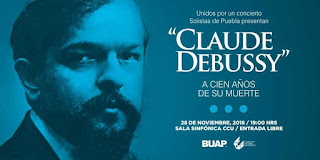Unidos por un concierto, Solistas de Puebla presentan “Claude Debussy” a cien años de su muerte
PROGRAMA
Syrinx para flauta sola – Eduardo Muñoz
Jardins sous la Pluie (Jardines bajo la lluvia) – Lire Campos Espejel (piano)
Petite Suite para piano a 4 manos – Claudia Cárdenas (piano), Rafael López Vera (piano)
Rêverie – Andrés de Rivera (piano)
Reflects dans l’eau (Reflejos sobre el agua) – Jaime Arellano (piano)
L’isle Joyeuse (La isla alegre) – Enrique Castillo (piano)
Romance (Romanza)- Elisa Avalos (soprano), Jaime Arellano (piano)
Les cloches (Las campanas) – Elisa Avalos (soprano), Jaime Arellano (piano)
Beau Soir (Hermosa tarde) – Elisa Ávalos (Soprano), Elena Ananyeva (piano)
Clair de Lune (Claro de luna) – Elena Ananyeva (piano)
Notes to the program One of the most powerful influences in the course of twentieth-century music was that of Claude Debussy (1862-1918). One of the aspects of his style is summarized in the term impressionism. This word was applied for the first time in a school of French painting that flourished from 1880, approximately and until the end of the century; its main representative is Claude Monet (1840-1926). In relation to music, impressionism is an approach to composition designed to create atmospheres and sensory impressions through harmonies and timbres. It differs from most programmatic music in that, first of all, it does not try to express deep emotions or tell a story, but to evoke a climate, a fleeting feeling, an atmosphere, with the help of suggestive titles, reminiscences of natural sounds, dance rhythms, melodic fragments and similar resources. Secondly, Impressionism is based on allusion and over-understanding and, in a certain sense, is the antithesis of the deep, vigorous and rectilinear expressions of the Romantics.
If you want more information about this exposition you have to click here.

Comentarios
Publicar un comentario